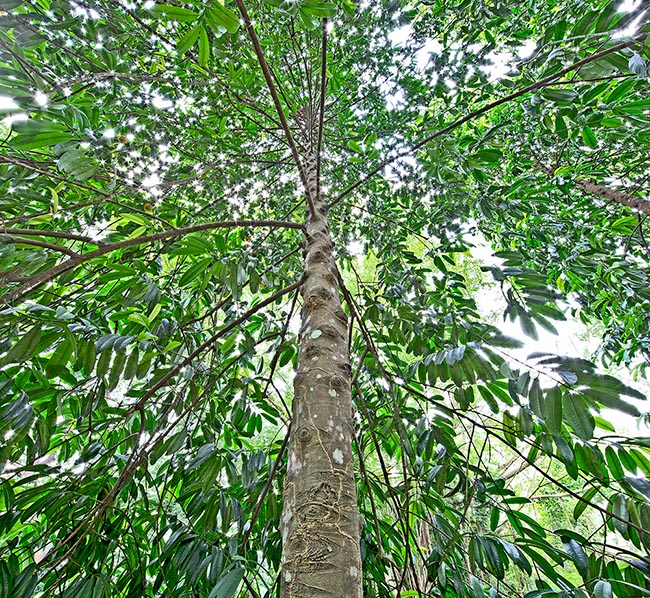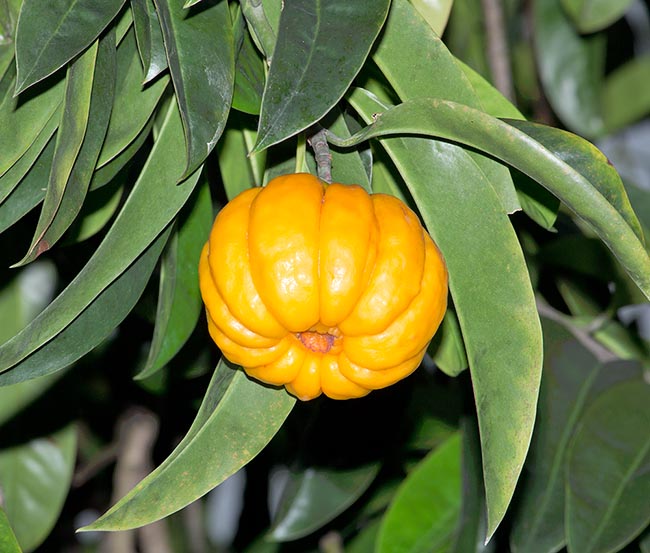Family : Clusiaceae

Text © Pietro Puccio

English translation by Mario Beltramini

Native to India, Malaysia, Myanmar and Thailand, Garcinia atroviridis is a dioecious tree reaching the 25 m of height with a 25 cm trunk hidden by a conical crown with drooping branches and dark leaves © Giuseppe Mazza
The species is native to India (Arunachal Pradesh and Assam), Malaysia, Myanmar and Thailand where live in the humid forests up to about 600 m of altitude.
The genus is honoured to the French botanist Laurent Garcin (1683-1751); the specific name is the combination of the Latin adjectives “ater, atra, atrum” = black, dark, and “viridis, e” = green, with reference to the colour of the leaves.
Common names : asam gelugor, asam potong (Indonesia); asam gelugo, asam keping, assam gelugor (Malaysia); cha muang, cha muang chang, ma kham khaek, rong thong, som khaek, som pha ngun (Thailand).
The Garcinia atroviridis Griff. ex T.Anderson (1874) is a dioecious evergreen tree, up to about 25 m tall, with conical crown with drooping branches and trunk enlarged at the base, erect, of about 25 cm of diameter, that shows a smooth bark in the young plants, tending to fissure with the age, of grey to blackish colour, that exudes from the incisions a transparent yellowish lymph.
The leaves, on a 1,5-3 cm long petiole, are simple, opposite, oblong-lanceolate with entire margin and brusquely pointed apex, 15-22 cm long and 5-8 cm broad, coriaceous, of glossy dark green colour; the young leaves are pinkish. Female flowers, on a 3 cm long peduncle, solitary, terminal, of 3,5 cm of diameter, with 4 concave orbicular sepals, yellow externally, suffused with red inside, 4 obovate petals with retroflexed apex, fleshy, of dark red colour, and stigma of the same colour. Male flowers, of 1,5 cm of diameter, in short (about 4 cm long) terminal racemes, with sepals and petals similar to the female ones as shape and colour, with numerous stamina merged at the base to form a ring.
The male flowers as well as the female ones have in a rudimentary form the organs of the other sex and in some instances are present hermaphroditic flowers; the female plants fructify also in absence of the male ones by parthenocarpy.

The fruits are subglobose berries with 9-16 ribs, of 7-10 cm of diameter and about 7 cm long, of initially green colour then yellow when ripe. Various parts of the plant hold medicinal virtues © Giuseppe Mazza
The fruits are subglobose berries with 9-13 ribs of 7-10 cm of diameter and about 7 cm long, of initially green colour, then yellow when ripe, with sepals and petals persistent at the base and stigma at the apex, with pulp of intense yellow colour, juicy, of particularly sour taste, containing numerous flattened seeds, 1,4 cm long, surrounded by an arilloid (false aril, outgrowth due to an enlargement of the involucre surrounding the ovule) of orange colour.
It reproduces by seed in draining loam rich of organic substance, maintained humid at the temperature of 25-28 °C, but often recourse is done to the grafting in way to be sure to have female plants.
Species suitable for the tropical and subtropical climate zones characterized by high annual rainfall, of relatively easy cultivation, requires full sun, but during the initial phase of growth, and is not particular about the soil provided the same is draining and maintained almost constantly humid.
The fruits, because of their particularly sour taste due to the presence of various acids (ascorbic, citric, malic, tartaric and especially hydroxycitric), are not consumed raw, but sliced and dried are added to various dishes to give a acidulous taste; the young leaves are consumed raw as salad or cooked. The dried fruits are also utilized, in some locations, as fixative for various natural colours.
Since ancient times the fruit is utilized in the traditional medicine for various pathologies: laboratory studies have evidenced in extracts of various parts of the plant the presence of bioactive compounds with interesting antioxidant, antihyperlipidemic, antinflammatory and antitumoral properties.
→ To appreciate the biodiversity within the CLUSIACEAE family please click here.
